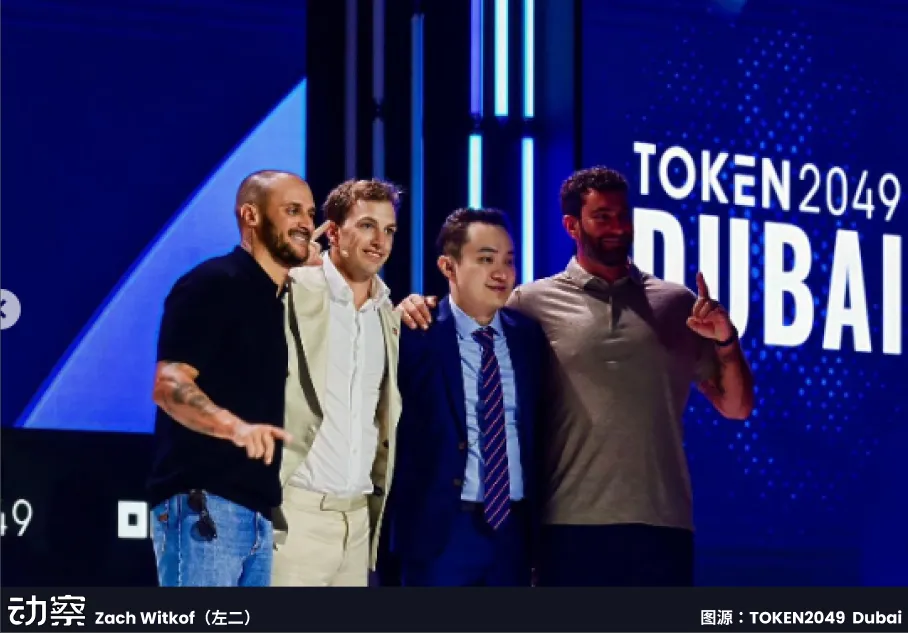Trump’s $10 billion power-for-money deal puts his own currency on Wall StreetRecommended Articles
Original source: Animal Observation
In August, amidst the pile of Nasdaq announcements, there was a seemingly ordinary financing announcement that exploded like a hidden bomb: ALT 5 Sigma issued up to 200 million common shares (approximately 10 billion RMB) at $7.50 per share, exchanging WLFI tokens for shares, and sent Trump’s youngest son Eric Trump to the board of directors.
Overnight, ALT 5, a fintech company with annual revenue of just $20 million, transformed itself into the “Trump family’s publicly traded treasury.” ALT 5 wasn’t just raising funds; it was brazenly pushing the Trump family’s token, WLFI, and its USD 1 stablecoin, both heavily politically stigmatized, into the U.S. securities system.
WLFI (World Liberty Financial) is not a simple startup, but a “political mint” created by the Trump family.
Founded two months before the US election, WLFI generated hundreds of millions of dollars in revenue for the family business through the stablecoin USD 1. In other words, ALT 5 leverages more than just a stablecoin; it leverages a comprehensive set of political and financial tools.
The question is – is ALT 5 really raising funds, or is it selling a ticket to wealth with the words “political dividends” written on it?
ALT 5’s Hidden Bloodline: The Connection Between Three Forces
A company’s shareholder list often tells more than its financial statements.
ALT 5’s shareholder structure is almost a power puzzle: offshore capital, Wall Street funds, and political tokenists are intertwined, making the company look both like a fintech company and a political-financial experiment.
What really makes ALT 5 tense is this type of shareholder: the political tokenists. Representative figures include Zach Witkoff and Eric Trump.
Eric Trump needs no introduction – he is the son of US President Trump. The family’s क्रिप्टो industry is currently under his jurisdiction and he has direct access to the ALT 5 board of directors.
It is worth mentioning Zach Witkoff, the co-founder of the WLFI stablecoin and chairman of ALT 5.
Judging solely by his resume, Zach Witkoff’s background clearly defines him as an extraordinary entrepreneur. He is the son of Steven Witkoff, a prominent New York real estate developer and current US special envoy for the Middle East.
The Witkoff family has decades of experience in Manhattan real estate and owns many landmark buildings. His father, Steven, has been involved in New York’s financial and political circles for many years.
The Trump family started its business in real estate, and Steven Witkoff has long had close ties with the Trump father and son in the New York real estate circle.
Zach’s relationship with the Trump family can be summed up in one sentence: real estate ties combined with political ties. Therefore, Zach and Eric’s relationship isn’t just a “cooperation”; it’s a family-style political and financial alliance.
If Eric Trump brings his family’s political resources to the table, then Zach Witkoff is the man who executes the Trump family’s financial operations. He is the key bridge in this intertwined political and financial landscape.
The presence of these two individuals suggests that ALT 5’s development path will become increasingly politicized. It’s not just about pursuing commercial expansion, but rather stockpiling financial tools for the 2025-2028 US political cycle. In a sense, it’s part of the Trump family’s financial arsenal.
Let’s take a look at one of ALT 5’s major shareholders, an offshore company registered in the Bahamas – Clover Crest Bahamas Ltd., which holds approximately 11% of the shares.
The reason is simple: they can enjoy relaxed tax policies while avoiding excessive regulatory scrutiny. The Bahamas is a well-known tax haven where many wealthy individuals and businesses register their companies.
In simple terms, Clover Crest is like a secret channel for the Trump family, which can not only quietly transfer money to ALT 5, but also isolate risks when needed.
Another source of shareholder power comes from Wall Street fund companies, such as the most familiar Vanguard Group. These funds are likely indirectly held by retail investors around the world because they operate large-scale index funds.
Vanguard’s stake in ALT5 isn’t significant, and it appears to be a passive investment. But the problem is: when the public sees a name like “Vanguard Group” listed among its shareholders, they intuitively perceive the company as legitimate and reliable. This is known as a “legitimate endorsement.”
These three forces each have different logics: offshore financiers provide hidden funding channels to ensure that money can come in; Wall Street funds provide facades and legitimacy to ensure that the company appears “compliant and formal”; political token factions provide narratives and strategic directions to push ALT 5 onto the global stablecoin stage.
The combination of these three makes ALT 5 both clean and dangerous.
On the surface, it is a law-abiding fintech company; in reality, it is being used as a “Trojan Horse” for stablecoins, quietly carrying the ambitions of politics and capital under the guise of compliance.
FinTech’s veneer: Where does the hidden door beneath compliance lead to?
On paper, ALT 5 appears to be a perfectly normal fintech company. It holds a full suite of licenses, offering a comprehensive suite of services, including a payment gateway, OTC trading, custody, and a white-label exchange. With annual revenue of approximately $20 million and a gross profit margin approaching 50%, it ranks highly in the crypto payments industry. Its compliance, transparency, and impressive data make it appear even cleaner than many traditional payment companies.
But what truly propelled ALT 5 from a niche tool-based FinTech to the global spotlight was its $1.5 billion funding round in August 2025. Overnight, it was no longer just an API company, but was propelled into a new position: becoming the “Nasdaq treasury” of Trump’s stablecoin WLFI.
This means that ALT 5 is no longer just a factory selling technology, but has become a key node in the globalization of stablecoins.
Why is it called a “backdoor”? The reason is actually very simple.
The first is the protection of surface identity. If the WLFI stablecoin wants to directly enter the payment networks of various countries, it will almost certainly run into the high walls of central banks and regulators.
However, ALT 5 has a pre-existing fintech license, allowing it to take a lead as a “payment API service provider.” Regulators see a compliant fintech company, not a politically charged stablecoin.
Secondly, it provides a secret channel for cross-border settlement. ALT 5 Pay’s API allows merchants to accept cryptocurrencies such as BTC and USDT, and then automatically convert them into US dollars or euros in the backend.
If WLFI/USD 1 is also embedded, merchants and users might not even realize they are using a stablecoin endorsed by the Trump family. While it may appear to be a “payment technology,” it actually facilitates the penetration of stablecoins.
Finally, it’s a natural integration into the global network. ALT 5 has already connected the Lightning Network and stablecoin payment systems, making it far more efficient than traditional cross-border payments that rely on SWIFT.
For many emerging markets with strong demand for the US dollar but lacking direct access to Wall Street, ALT 5 provides an invisible express lane. Through it, WLFI can quickly “sink” and enter the global trading scene with extremely low resistance.
In this way, the significance of the $1.5 billion financing becomes clear: it is not simply expansion funds, but more like a strategic deployment to lay a global payment pipeline for WLFI.
ALT 5 can naturally continue to assure regulators that “we are just a payment company that provides a compliant API.” But in the dark, its interface may be becoming a track for stablecoins to bypass the traditional financial system.
This dual narrative has made ALT 5 a classic “fintech front.” Externally, it appears clean, transparent, and professional, a textbook example of FinTech. Internally, however, it is being promoted to a strategic level, becoming an indispensable piece in the globalization of stablecoins.
This may be the key to WLFI’s rapid transition from a political concept to a real financial instrument: it found a “legal backdoor” like ALT 5.
When the compliance cover is thick enough, stablecoins can quietly flow into the daily transactions of merchants and users, and by the time regulators really react, the door may have already been completely opened.
Trump’s shadowy financial empire
ALT 5 is just the tip of the iceberg. The bigger picture underneath is the Trump family building its own dollar system.
They have tied politics, media, finance and mining together: using voter communities as entrances, turning attention into assets, using compliance as a channel, and using computing power and Bitcoin reserves as ballast.
On the surface, it is a few financings and new products, but in essence it is a rearrangement of the US dollar chain: entry, pricing, clearing, and reserves each have corresponding pieces.
The challenge of this landscape lies not in “decentralization” but in the redistribution of power: who defines the on-chain dollar, who tells the story of asset prices, who can write it into financial statements, and who controls the underlying credit. This isn’t an experiment with a single coin, but a shadow Wall Street that circumvents Wall Street.
From a political perspective, Trump’s version of the stablecoin USD 1 is the financialization of political identity.
In the world of stablecoins, USDT and USDC represent the market and institutions. The former dominates global exchanges with its gray-zone liquidity, while the latter has won the favor of mainstream financial institutions thanks to its regulatory compliance and Wall Street credibility. USD 1, however, has a completely different positioning—it’s a stablecoin for Trump supporters.
This is a currency with a distinct political overtone. Its creation logic is not to “improve payment efficiency” or “reduce cross-border costs,” but to tie political identity to financial assets.
For the Trump family, USD 1’s strategic significance lies in its role as a 24/7 fundraising pool, a community-building tool, and an extension of the dollar narrative. If USDT is the trader’s dollar and USDC is Wall Street’s dollar, then USD 1 is Trump’s dollar. It transforms a party’s political identity into a tradable financial system.
This design is both extremely risky and highly explosive. The risk lies in the fact that USD 1 could be labeled an “illegal financial instrument” if political parties change or the judiciary intervenes. The potential for explosive growth lies in the fact that it no longer requires building a market from scratch; as long as tens of millions of loyal supporters can be involved, a large, cohesive monetary community can naturally form.
From a media perspective, from Truth Social to मेम सिक्का, attention is currency.
If USD 1 is the Trump family’s “financial weapon,” then the media is its “powder depot.” Without sufficient attention and narrative, even the most perfect stablecoin design will remain on the cold, cold ledger.
The first piece of the puzzle is Trump Media & Technology Group (TMTG), whose Truth Social has become a forum for right-wing media.
Here, political mobilization and information dissemination are highly homogenized – every opinion and every speech of Trump can spread rapidly on the platform.
Another piece of the puzzle is the meme coin. The issuance of $TRUMP and $MELANIA coins is the family’s experiment in directly monetizing attention.
This combination of media and finance has created a closed loop of “narrative-traffic-monetization”: political events ignite public opinion → public opinion ferments on Truth Social; Meme coins become an outlet for emotions, quickly absorbing hot money; TMTG treasury and stablecoin USD 1 take over funds, turning short-term emotions into long-term assets.
On the financial level, it is ALT 5 that we have talked about from beginning to end, which includes tokens in US stock financial reports.
The last piece of the puzzle is mining and Bitcoin reserves.
American Bitcoin, a family-backed company, has launched a merger and reverse merger program to go public, targeting resources in Asia and North America. In North America, the company primarily controls mining and energy pricing.
The capital forces behind the Trump administration (real estate, energy, and finance) are already closely tied to oil, gas, and infrastructure, making it easy for them to acquire Bitcoin mining farms. Therefore, they control the “mining production end” within their own coordinated network, integrating the three pillars of “computing power, assets, and secondary markets.”
Therefore, the Trump family’s crypto empire is essentially a “shadow dollar power struggle” and a provocation to the traditional Wall Street financial order.
The political layer provides identity and funding pools; the media layer creates traffic and cash flow; the financial layer writes tokens into financial statements; and the mining layer uses computing power and Bitcoin reserves to put the final stone on this machine.
end
So the real danger lies not in USD 1 itself, but in the fact that an underground copy of the US dollar has started operating, and the operator is not the Federal Reserve or Goldman Sachs, but the Trump family.
Alt 5 is the gateway, WLFI/USD 1 is the flag, Truth Social and Meme Coin are the megaphones, and the Bitcoin mining industry is the ballast. On the surface, they appear unrelated; in reality, they are intertwined into a political and financial machine, operating in the shadows.
The ambition of this machine is not to create a “compliant version of USDT”, but to use WLFI to weld finance and politics together, turning payment into voting, making the flow of funds the flow of voters, and allowing the capital market to directly respond to the election battlefield.
If Wall Street is the main palace of the US dollar, then the Trump family is quietly building a secret channel to divert the blood of the US dollar to its own parallel empire.
यह लेख इंटरनेट से लिया गया है: Trump’s $10 billion power-for-money deal puts his own currency on Wall StreetRecommended Articles
Related: How does PoL v2 reshape $BERA’s value capture path?
1. The core breakthrough of PoL v2: from liquidity incentives to value closed loop The mainnet asset dilemma of traditional public chains has existed for a long time. Although tokens such as ETH and SOL bear the functions of gas and consensus, it is difficult to directly capture the growth of ecological value. Berachains PoL (Proof of Liquidity) mechanism attempts to solve this problem through chain-level incentive redistribution, and the key iteration of version v2 is to transfer 33% of DApp bribery incentives from BGT pledgers to BERA pledgers. This adjustment may seem subtle, but it is actually a paradigm shift in the mainnet asset value model. Although PoL v1.0 has successfully leveraged the growth of ecosystem TVL (according to DefiLlama data, Berachain mainnet TVL exceeded $1.2B in 3 months…







